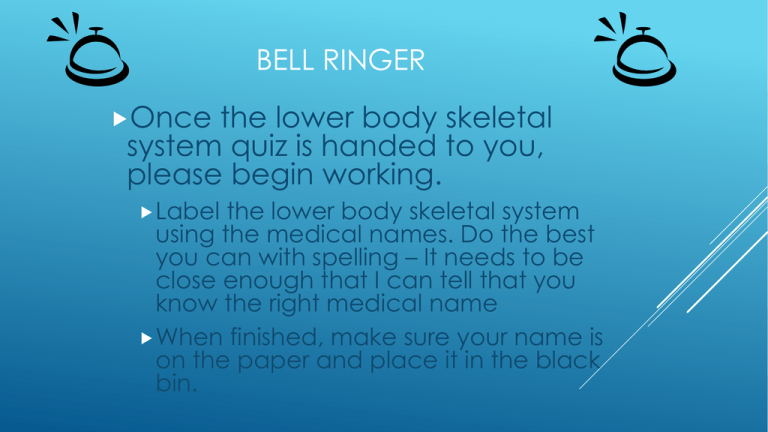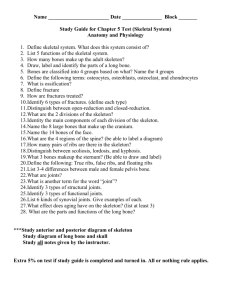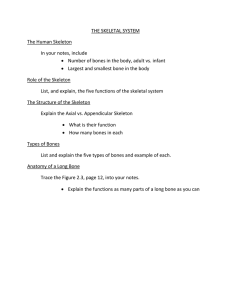Once the lower body skeletal system quiz is handed to you,
advertisement

BELL RINGER Once the lower body skeletal system quiz is handed to you, please begin working. Label the lower body skeletal system using the medical names. Do the best you can with spelling – It needs to be close enough that I can tell that you know the right medical name When finished, make sure your name is on the paper and place it in the black bin. PROBLEMS WITH THE SKELETAL SYSTEM About the Skeletal System cont. OBJECTIVES Content Objective: The students will be able to identify and define problems with the skeletal system through partner discussion and completing notes. Language Objective: The students will be able to apply the definition of the prefix “osteo” to various words in order to discover their meaning. REVIEW 1. What does the prefix “osteo” mean 2. Which type of joint allows for the greatest freedom of movement? 3. What does the word ossification refer to? 4. What are the four main functions of the skeletal system? 5. Where is cartilage located in your body? TYPES OF JOINTS - REVIEW Ball and Socket What movement does it allow? Where is it located in the body? Hinge Joint What movement does it allow? Where is it located in the body Gliding Joint What movement does it allow? Where is it located in the body? Fixed Joint What movement does it allow? Where is it located in the body? PROBLEMS WITH THE SKELETAL SYSTEM Osteoporosis Rickets Bowed-Legs Fractures Complete Compound Stress Osteoarthritis OSTEOPOROSIS What does the prefix osteo mean? Due to this prefix we know the term osteoporosis has to do with what? Osteo = Bone What does the word porosis mean or sound like? Porosis = Porous condition OSTEOPOROSIS Causes bones to become weak and brittle Brittle to the point that a simple fall, cough or bending over can cause a fracture Most frequent injures occur in the hip, wrist or spine Caused when the creation of bone does not keep up with absorption of bone What cell creates bone? What cell absorbs bone? Frequently Occurs in Older Women past Menopause RICKETS Caused by lack of Vitamin D, calcium or phosphate causing the weakening and softening of bones Rickets can be caused by your genes, kidney disorder, disorders of the liver Rare in the United States but can occur when children are rapidly growing BOWED-LEGS Common in toddler Looks Like – When feet together there is a distinct space between knees and lower legs Cause – Either one or both legs curve outward The bowing is typically corrected by age 3 or 4 Fractures FRACTURES Occur when a physical force exerted on a bone is stronger than the bone COMPLETE FRACTURE The bone is fractured completely across COMPOUND FRACTURE Open fracture where there is a break in the skin around the bone The outside air, dirt must be able to get to the fracture for it to be a compound STRESS FRACTURES Tiny cracks in the bones Caused by repetitive application of force Typically overuse injury Example: Runners get stress fractures in tibia Also caused from osteoporosis OSTEOARTHRITIS Most common form of arthritis Wear and tear arthritis Cause – Protective cartilage on the ends of bones wears down over time Most Common: Hands, neck, knees, hips, lower back RIBS – TRUE, FALSE AND FLOATING True Ribs – One of the first 7 pairs of ribs which attach to the sternum False Ribs – The lower 4 pairs of ribs that do not directly connect to the sternum • The last 2 pairs of false ribs are not attached and called the floating ribs DIFFICULT WORDS MADE EASY WORKSHEET Write the medical name from the word bank next to the common bone name When finished turn your paper over and review your completed skeleton SKELETON PROJECT DIRECTIONS You may work alone or in a group of NO MORE than 3 Reminder: If you work in a group, participation points can be deducted at any time that you or your group are off task so make a responsible decision with who you work with You will not be able to use any of your notes during class time, but you may study them after class as we will be working on this project for a couple class periods DIRECTIONS 1. You will cut out and color the bones that make up the human body. 2. After all bones are colored and cut, you will assemble the skeleton inside of a manila folder (gluing the bones to the folder in their correct anatomical position) 3. Prior to gluing the bones down lay them all out to make sure they all fit and you have right and left in the correct places Once all bones are laid down, you will label each of the bones with their medical and common name (if it has a common name) In addition to labeling everything we labeled on the skeleton we completed in class, you will need to label the teeth, false ribs, true ribs and floating ribs. Once all parts of your skeleton are labeled with the medical name and the common name, you will circle and label the 4 joints discussed in class (Ball & Socket, Hinge, gliding, and fixed) DIRECTIONS CONTINUED Once your skeleton is completely labeled, you will write (using complete sentences) the four functions of the skeletal system and one way that they demonstrate that function. What are some examples? Finally, you will write in complete sentences) four problems with the skeletal system and identify what that problem means. What are some examples from class today? Grading: 55 Points 45 Points – For accurately labeling and assembling all bones as well as completing the function and problem bubbles. 10 Points – For participating with your group and completing the reflection.





